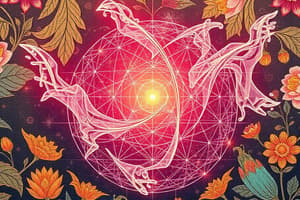Podcast
Questions and Answers
What is matter?
What is matter?
Anything that occupies space and has mass that's composed of atoms that form as molecules.
Which of the following are examples of visible or microscopic matter? (Select all that apply)
Which of the following are examples of visible or microscopic matter? (Select all that apply)
- Dust (correct)
- Steel (correct)
- Air (correct)
- Wood (correct)
What are the common states of matter?
What are the common states of matter?
- Liquid (correct)
- Solid (correct)
- Plasma
- Gas (correct)
Match the following types of solids with their descriptions:
Match the following types of solids with their descriptions:
What is a crystalline solid?
What is a crystalline solid?
What is an amorphous solid?
What is an amorphous solid?
What characterizes a liquid state of matter?
What characterizes a liquid state of matter?
What characterizes a gaseous state of matter?
What characterizes a gaseous state of matter?
What are the two forms that matter and its composition can come in?
What are the two forms that matter and its composition can come in?
What is a pure substance?
What is a pure substance?
What is an element?
What is an element?
What is a compound?
What is a compound?
What is a mixture?
What is a mixture?
How can mixtures be classified based on their uniformity?
How can mixtures be classified based on their uniformity?
What is a heterogeneous mixture?
What is a heterogeneous mixture?
What is a homogeneous mixture?
What is a homogeneous mixture?
Matter can be either ____ or ______.
Matter can be either ____ or ______.
Pure substances can be ____ or _____.
Pure substances can be ____ or _____.
Mixtures can either be _____ or ______.
Mixtures can either be _____ or ______.
What can mixtures be composed of?
What can mixtures be composed of?
What are the two ways to tell matter apart?
What are the two ways to tell matter apart?
What are properties in chemistry?
What are properties in chemistry?
Study Notes
Matter
- Defined as anything with mass that occupies space, composed of atoms forming molecules.
- Although it may seem smooth, matter's properties derive from its atomic and molecular structure.
Types of Matter
- Visible matter includes solid objects like steel, water, wood, and plastic.
- Microscopic matter comprises air and microscopic dust, all made of atoms.
States of Matter
- Solid: Atoms or molecules are closely packed, maintaining a fixed volume and rigid shape with limited movement.
- Liquid: Atoms or molecules are close yet can move around each other, having a fixed volume but taking the shape of their container.
- Gas: Atoms or molecules are far apart, allowing for compressibility and taking the shape and volume of their container.
Types of Solids
- Crystalline Solids: Atoms or molecules are arranged in a long-range, repeating geometric pattern. Examples include salt and diamond.
- Amorphous Solids: Atoms or molecules lack long-range order, such as in glass, rubber, and plastic.
Classification of Matter
- Matter and its composition can exist as Pure Substances or Mixtures.
Pure Substances
- Consist of a single type of atom or molecule. Examples include helium and water.
- Can be classified into two categories: Elements (indivisible) and Compounds (composed of multiple elements in fixed proportions).
Elements
- Pure substances that cannot be broken down into simpler substances through chemical means.
Compounds
- Combinations of two or more elements in fixed ratios. Decomposable into simpler substances. Common examples include water and table salt.
Mixtures
- Composed of two or more different types of atoms or molecules that are physically combined, not chemically. Common in everyday life, including juice, air, and soil.
Types of Mixtures
- Heterogeneous Mixture: Composition varies from one region to another, such as oil and water.
- Homogeneous Mixture: Uniform composition throughout, such as sweetened tea.
Additional Classifications
- Mixtures can contain two or more elements, two or more compounds, or a combination of both.
Properties of Matter
- Physical and chemical properties help distinguish different substances.
- Properties are characteristics that set one substance apart from another.
Studying That Suits You
Use AI to generate personalized quizzes and flashcards to suit your learning preferences.
Description
Dive into Chapter 3 of Introductory Chemistry with these flashcards covering key concepts related to matter. Learn the distinctions between visible and microscopic matter along with definitions and properties of matter. Perfect for reinforcing your understanding of foundational chemistry concepts.





